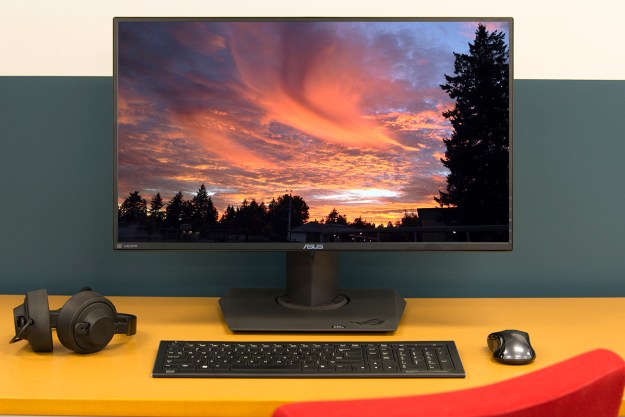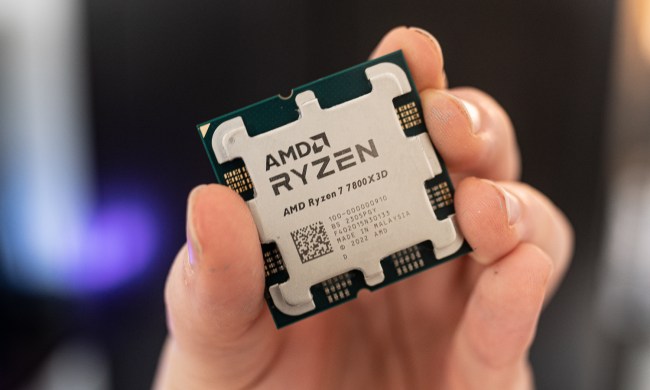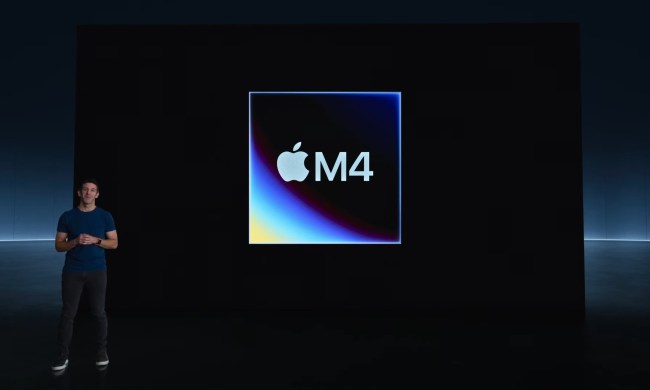
“The ROG Swift PG279Q lives up to its flagship aspirations, and sets a new standard for gaming monitors.”
- Attractive design
- Highly adjustable stand
- Intuitive controls
- Spot-on color accuracy
- Insane 165Hz refresh rate
- Limited input options
- Gamma is too dark
- Expensive for 1440p resolution
There’s a lot of things gaming monitors need to nail to be worth the money. The Republic of Gamers Swift PG279Q does nearly that with it’s 27-inch, 2,560 x 1,440 display, boasting a very low four millisecond gray-to-gray response time, but more importantly, G-Sync compatibility and a maximum refresh rate of 165Hz. That’s the highest we’ve seen yet, and a good 21Hz “better” than the previous maximum of 144Hz.
But is the 21Hz jump noticeably better? That’s a key question that must be answered. The PG279Q’s retail price is $800 – extremely steep for a 1440p display, and about $130 more than Asus’ early 144Hz gaming display. In other words, you’re paying about six bucks per extra frame of refresh per second. Let’s see if that’s a good deal.
Design
Most monitors are boring to look at, with chunky gray or black bezels attached to drab silver stands. But the Asus’ PG279Q is not most monitors. It combines bezels just a quarter-inch thick with a large, triangular stand neck, and red LED-backlit accents and Republic of Gamers logo. The look won’t be for everyone, but it stands out without going completely over the top.
I honestly can’t think of a single flaw in the PG279Q’s design.
The monitor is as functional as it is attractive. The wide stand base keeps the monitor in place, while the stand neck provides all the adjustments expected of a good office display; height, pivot, tilt, and rotation up to 90 degrees. There’s also a small wire routing cut-out in the stand neck to help tame clutter.
I honestly can’t think of a single flaw in the PG279Q’s design. Even the backlit logo is not so bright to be overly distracting, and it can be turned off if desired.
Connectivity
Input options are a bit limited with the PG279Q. It offers HDMI 1.4a and DisplayPort 1.2a, and just the latter supports G-Sync. Compared to monitors as a whole, this is a limited selection of connectivity, but it’s actually more than the average G-Sync display provides. The monitor also offers two USB 3.0 ports, but they’re tucked away near the video inputs and difficult to use.
Menu options
The PG279Q’s on-screen menu is tucked away in the lower right hand flank, as is typical, but operates a bit differently than most. The top button is actually a joystick, and is used to navigate the majority of the options. The joystick can be pressed or tilted to select options. The other buttons, from top to bottom, are the exit button, a quick-access button for gaming-related settings, a turbo button (for changing refresh rate), and the power button.
This scheme works well, and is easily the best implementation of a joystick control scheme I’ve yet seen on a monitor. It’s helped by the fact the joystick itself is small, smooth and requires little effort to use.
It’s good the controls work well, because there’s a lot to navigate. The menu includes a wide selection of GameVisualizer pre-sets that are optimized for certain genres, five levels of blue light filtering, color temperature adjustments, brightness, and contrast. But while there’s a lot to choose from, there’s not much discrete control. Color temperature settings are simply “warm” or “cool,” and expert adjustments like color saturation, hue and gamma are not included. Arguably they’re not the focus of a gaming monitor, but I think they should be a part of any monitor as technically capable – and expensive – as this.
The star of the show is the overclocking feature, which enables a refresh rate of up to 165Hz. This is not on by default, so the monitor is set to a 60Hz refresh rate out of the box, with an option to switch to 120Hz. Despite the use of the scary term, “overclocking,” setting the monitor to 165Hz is easy to do, requiring nothing except a reboot of the monitor’s firmware. We didn’t notice any negative effects from using it, so I think most users will turn it on and leave it on for the life of the monitor.
Pre-calibration quality
Like most monitors, the PG279Q presents an overly bright and extremely bold image out of the box. That’s great for a store shelf, but it’s a bit much for home use. Still, out-of-box image quality is quite respectable, particularly in the area of color reproduction. Games look well saturated and vivid on this display. Depth doesn’t live up to quite the same standard, but there’s enough perceived contrast to provide a three-dimensional look to high quality graphics. The IPS panel provides excellent viewing angles on both the horizontal and vertical axis.
Calibrating the display transforms it into a truly excellent panel.
These impressions were backed up by the test results. They found the display’s maximum brightness reaches an incredible 391 lux, making it one of the brightest monitors we’ve ever reviewed. Color gamut came in at 100 percent of sRGB and 78 percent of AdobeRGB, and average color error came in at DeltaE 2.17. Anything below one is considered generally unnoticeable to the naked eye. Surprisingly, the color error was fairly well distributed – cyan and blue saw the highest error, which is normal for LED backlit
Overall, the PG279Q performs well. It isn’t exceptional in any particular area, but it’s in the upper tier of results across the board. There’s just one exception to that – gamma. We measured a curve of 2.4, which is off the target of 2.2. Most competitors come in at the ideal 2.2, or at 2.1. Higher numbers represent darker reproduction of grayscale.
In practice, this means that images will appear darker than they should. It’s not a huge concern for gamers, but it’ll be a problem for anyone who edits photos, videos, or other digital media, given the monitor provides no option for gamma adjustment.
Post-calibration quality
While the PG279Q performs well out of the box, calibrating the display transformers it into a truly excellent panel. This is mainly because of color accuracy. After calibration the AdobeRGB gamut rose to 79 percent and color accuracy dropped to an average of .81, which is near perfection, and the third best result we’ve ever seen – behind the Samsung U32D970Q and the display on the Zenbook NX500 notebook. Contrast happily remained at a respectable ratio of 630:1 despite the fact my calibration more than halved the maximum brightness of 391 lux to a more reasonable 120 lux.
Nothing I could do changed the gamma curve, though, and that’s going to remain an issue for anyone looking to do professional work alongside gaming. It also might be a problem for gamers who enjoy dark games, because a curve of 2.4 means the display is rendering images darker than it should, which can result in loss of detail in shadowy scenes (you literally may not see the bad guy that gets you). Fortunately, most modern games have in-game tools to increase gamma through software, so it should be possible to tame it.
I also flipped through the refresh rate settings to see if, by chance, they changed image quality. They did not – which is what should be the case. Color accuracy is the same at 165Hz as it is at 60Hz. The blue light filter hurts color accuracy, though the display actually manages a delta error of only 1.5 at the first level of filter, which is still quite good.
G-Sync at 60, 144 and 165 Hz
Testing complete, I kicked back, relaxed and played some games. For the most part I stuck to Diablo 3, a long-time favorite of mine, and a game that benefits greatly from high refresh rates and frame synchronization. I also played World of Warships and Grand Theft Auto V, games that aren’t as ideal for showcasing the PG279Q.
Try as I might, I couldn’t see much difference between gaming at 144Hz and 165Hz.
I came away liking the monitor a great deal, but not specifically because of its high refresh rates. Try as I might, I couldn’t see much difference between gaming at 144Hz and 165Hz. Maybe animations in Diablo 3 looked smoother sometimes, or maybe they didn’t. It’s hard to say. Certainly, the major issues that are tamed by G-Sync, stuttering and screen tearing, were no different. They’re no different at 165Hz than at 60Hz.
Most games don’t provide full use of the maximum refresh rate, anyway. Even Heroes of the Storm doesn’t max out the 165Hz potential on our test rig, which has a Core i7-6700K processor and GTX 980 Ti graphics card. Framerates are usually in the 130 to 140 FPS range. Grand Theft Auto V dips below 60 FPS with all the details turned up, and World of Warships has a strange engine cap of 72 FPS.
Put simply, while the refresh rate is nice to have, I don’t know that even a 144Hz refresh rate is worth much, never mind 165Hz. The feature functions as intended, but it doesn’t bring a lot to the table. Personally, I’d be happy with a 60Hz refresh rate on a G-Sync monitor.
It has speakers, but does anyone care?
There are two speakers, rated at two watts of power each, on the backside of the PG279Q. As with most monitors, they serve little purpose aside from bare-minimum audio for gamers who’ve lost their speakers or headphones. Audio is reasonably clear at medium volume, but tends to distort when significant bass is introduced. The rear-facing location also means audio does not travel well when the display is pushed up near a wall.
Warranty
Asus ships the PG279Q with a three year limited warranty. That’s typical for monitors in this price range – in fact, a few offer a five year warranty, though no competitor with G-Sync compatibility does at this time.
Our take
Asus has a mission to make the Republic of Gamers product line world-class in every category, and the ROG Swift PG279Q spares nothing in search of that effort. It offers not just excellent image quality, but also a high refresh rate, frame synchronization through G-Sync, and design that’s as attractive as it is functional. Gaming monitors have a somewhat deserved reputation for sacrificing image quality at the altar of response times, but no such compromise exists here.
The monitor isn’t perfect. The gamma curve is too dark, which can lead to problems with visible detail in very dark games. I’d also like to see more inputs. And I suppose the response time of four milliseconds isn’t the lowest, but that likely only matters for Counter Strike players with professional aspirations.
You might think, given high refresh rate’s failure to noticeably change gameplay, that this $800 monitor is a poor value. That’s not the case. There are several competitors on the market, like the Acer XB270HU and Asus’ previous PG278Q, the latter of which is only $670. But the alternatives generally use a TN panel, and they can’t match the color gamut and viewing angles of the PG279Q’s IPS screen. While the refresh rate is the headline feature, the quality panel is what really makes Asus’ latest efffort its greatest.
It remains true that $800 is a lot to spend on a 1440p monitor, but if you want G-Sync, and you want both image quality and refresh rate, there are few alternatives. I also rather like the older Acer XB280HK, which provides 4K resolution – but with a much narrower color gamut and 60Hz refresh rate, it’s really no longer in the same league. The newer Acer XB270HU, meanwhile, did not hold up well in our contrast testing. The ROG Swift PG279Q lives up to its flagship aspirations, and sets a new standard for G-Sync gaming monitors.








